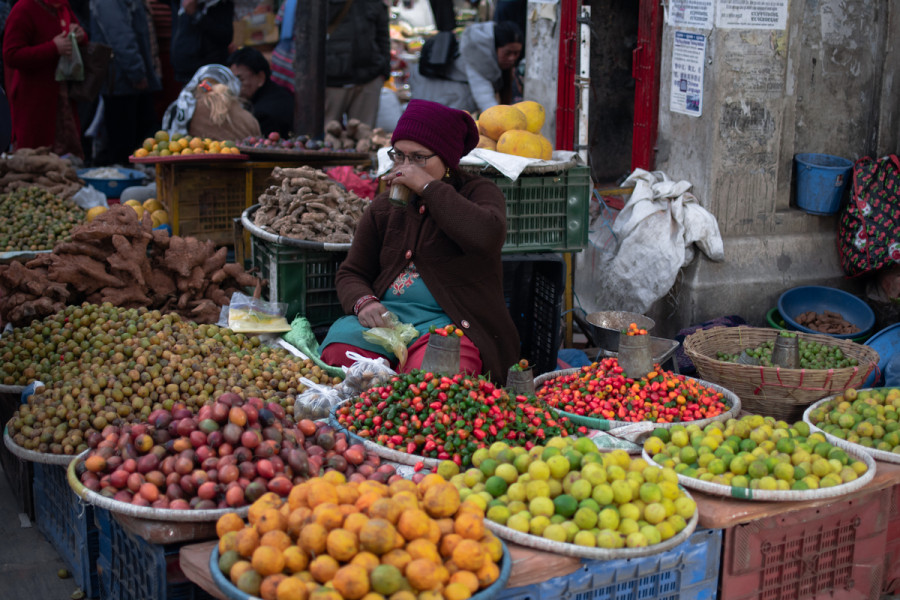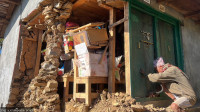Columns
Why the agriculture supply chain couldn’t be saved
Revamping the ecosystem of the agricultural value chain requires concerted efforts.
Roshee Lamichhane
That vegetable and fruit prices are spiralling out of control while farmers’ produce rot in the fields during the lockdown is a clear testimony of a complete breakdown of the agricultural supply chain in Nepal. Farmers standing in long queues at fertiliser depots to buy urea ignoring social distancing rules not only raises the risk of contagion, but also points to possible shortages due to lowered output for lack of inputs during the growing season.
Agriculture was expected to be least affected by Covid-19 as farms provide the perfect opportunity to work by maintaining social distance. The only thing needed was government support to ensure a steady supply of inputs and unhindered market access for the harvests. But except for extending the lockdown in various phases, governments of all levels—federal, provincial and local—failed to fulfil these primary duties. The lockdown lasting almost seven months caused untold miseries to the peasants due to non-availability of critical inputs like seeds and fertilisers, acute shortage of farmhands and transport embargoes and restrictions, making the agro-infrastructure all the ricketier and fragile. A sudden decline in incomes due to job losses and salary cuts has resulted in a huge contraction in demand too.
Supply-demand mismatch
Though prices of staples remained more or less stable, perishable goods, especially vegetables and fruits, became hugely expensive. Panic buying and hoarding on the part of consumers resulted in a sharp spike in prices. Despite government assurances of adequate supplies, food stocks are fast depleting. The dwindling inventory may not be enough to meet demand if the lockdown persists with its bottlenecks in logistics and impediments for free movement of labour.
The latest figures released by the Ministry of Industry, Commerce and Supplies show that imports of staple items, lentils, vegetables and fruits, milk-related items, raw materials for medicines, and processed medicines gained momentum in the five months from the start of the lockdown. At the same time, the production of processed foods suffered due to lack of labour and restrictions on the movement of people and products. All this raises a question about the efficacy of Nepal’s market infrastructure.
The immediate fallout is increased risk of food insecurity resulting in malnutrition and under-nourishment. There is no denying the fact that a prolonged supply-demand mismatch will automatically result in skyrocketing inflation. Making available nutritious food to the needy and vulnerable sections of society will pose a greater challenge. With agricultural produce going down the drain, the much-touted agri-ambulance launched by Province 5 seems to have proven to be ineffective. A drastic decrease in demand and market-disconnect during the lockdown has resulted in wastage of milk. Such wastage could have been easily avoided by converting fresh milk into powder using simple and inexpensive technology.
Covid-19 has led to many people in urban and semi-urban areas procuring agricultural products online. In order to effectively mitigate the precarious situation prevailing currently, a digitisation-driven agricultural supply ecosystem has become paramount. Having understood changing consumer sentiments and behaviour, popular agro websites have been supplying mostly organic farm products directly from the farms to people’s doorsteps. While efforts to modernise agriculture in Nepal have been limited to urban areas, in neighbouring countries like Bangladesh, locals have initiated virtual call centres to help connect rural farmers with suppliers and buyers at the individual level, an example that is worthy of emulation.
India could achieve a digital revolution through IT-enabled infrastructure and mobile telephony services to effectively support rural farmers with an uninterrupted supply of inputs such as seeds, fertilisers and chemicals. In this context, e-commerce platforms are facilitating the extension of the whole gamut of digital services. It’s time that local governments also came up with policies for e-delivery companies to do their part in making the supply chain robust and vibrant. It makes sense to permit them to supply groceries with all safety protocols instead of allowing consumers to crowd the market places and risk their lives in the process. Now, as an extension to their earlier business model, online delivery companies have started delivering agro products along with non-agro products. This is a welcome sign befitting the altered market scenario.
Policy imperatives
Structural inefficiencies seriously come in the way even if we try mimicking other economies for improvements locally. Nevertheless, there is a lot of scope for learning by catching up with some of the best practices of comparable economies in the region. Fiscal priorities should centre on cold storage, transportation, harvest technologies and irrigation and minimise food wastage. Though precise figures are not available, roughly 30 percent of the fruits and vegetables grown in Nepal rot before they reach the consumer for want of adequate storage and transport facilities.
As this issue has been exacerbated during the lockdown, it would be in the fitness of things if the government sets up a specialised task force not only for assessing the possible losses in agriculture but also for coming up with a strategic plan with remedial measures. If we fail to reckon the ramifications of the lockdown, hunger and livelihood related issues will become aggravated sooner than later. Also, a massive influx of returnees from abroad will intensify the problem by increasing demand. The government appears to have failed to garner the skill sets of the reverse migrants by involving them in agricultural activities as was suggested by the former finance minister in his budget speech.
A resilient supply chain in agriculture alone can provide a much-needed safety net amid a sagging economy. Thus, revamping the entire ecosystem of the agricultural value chain requires concerted and focused efforts from the government and market players alike. Resurrecting the broken supply chains and restoring their potential at the earliest should become a national priority where only the government can take the lead.
***
What do you think?
Dear reader, we’d like to hear from you. We regularly publish letters to the editor on contemporary issues or direct responses to something the Post has recently published. Please send your letters to [email protected] with "Letter to the Editor" in the subject line. Please include your name, location, and a contact address so one of our editors can reach out to you.




 16.12°C Kathmandu
16.12°C Kathmandu.jpg)















